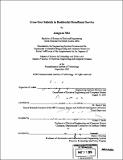| dc.contributor.advisor | David Clark. | en_US |
| dc.contributor.author | Min, Jungwon, S.M. Massachusetts Institute of Technology | en_US |
| dc.contributor.other | Massachusetts Institute of Technology. Dept. of Electrical Engineering and Computer Science. | en_US |
| dc.date.accessioned | 2006-11-07T12:47:43Z | |
| dc.date.available | 2006-11-07T12:47:43Z | |
| dc.date.copyright | 2005 | en_US |
| dc.date.issued | 2005 | en_US |
| dc.identifier.uri | http://hdl.handle.net/1721.1/34538 | |
| dc.description | Thesis (S.M.)--Massachusetts Institute of Technology, Engineering Systems Division, Technology and Policy Program; and, (S.M.)--Massachusetts Institute of Technology, Dept. of Electrical Engineering and Computer Science, 2005. | en_US |
| dc.description | Includes bibliographical references (p. 38-40). | en_US |
| dc.description.abstract | The rapid growth of Internet traffic has made Internet Service Providers (ISP) struggle to upgrade network capacity and to maintain service quality. The increase in the broadband usage impacts the cost of an ISP through usage-associated costs such as incremental usage cost, cost for expanding the network capacity, and cost from subscriber churns. This paper attempts to understand the relation between broadband usage and incremental usage cost. This thesis addresses issues on connecting the broadband usage to the usage-sensitive costs. How much do the light users spend to support the heavy users by paying the equal usage fee? To answer the question, it should be investigated how much incremental cost is generated by using networks and how the traffic load is distributed over the users. The research is based on the commercial broadband usage data sample and the published financial statements from a major broadband service provider in Korea, Korea Telecom. Analyzing the broadband usage reveals to us what the usage distribution looks like and how the distribution evolves over time. | en_US |
| dc.description.abstract | (cont.) By examining the published financial data, the cost directly associated with the broadband usage is estimated. The usage distribution and the estimated cost is incorporated to find an answer to how much burden the light users are carrying to subsidize the heavy users on the network under the current flat usage fee system. | en_US |
| dc.description.statementofresponsibility | by Jungwon Min. | en_US |
| dc.format.extent | 40 p. | en_US |
| dc.format.extent | 1618736 bytes | |
| dc.format.extent | 1620303 bytes | |
| dc.format.mimetype | application/pdf | |
| dc.format.mimetype | application/pdf | |
| dc.language.iso | eng | en_US |
| dc.publisher | Massachusetts Institute of Technology | en_US |
| dc.rights | M.I.T. theses are protected by copyright. They may be viewed from this source for any purpose, but reproduction or distribution in any format is prohibited without written permission. See provided URL for inquiries about permission. | en_US |
| dc.rights.uri | http://dspace.mit.edu/handle/1721.1/7582 | |
| dc.subject | Technology and Policy Program. | en_US |
| dc.subject | Electrical Engineering and Computer Science. | en_US |
| dc.title | Cross-user subsidy in residential broadband service | en_US |
| dc.type | Thesis | en_US |
| dc.description.degree | S.M. | en_US |
| dc.contributor.department | Massachusetts Institute of Technology. Department of Electrical Engineering and Computer Science | |
| dc.contributor.department | Massachusetts Institute of Technology. Engineering Systems Division | |
| dc.contributor.department | Technology and Policy Program | |
| dc.identifier.oclc | 70963145 | en_US |
